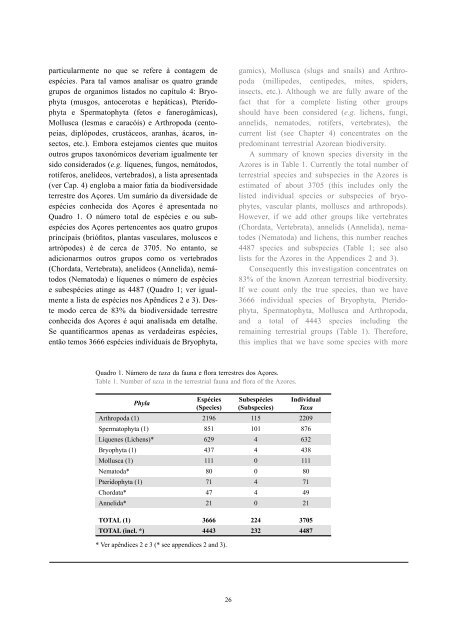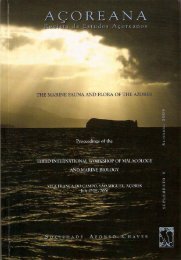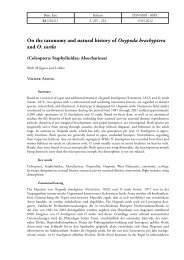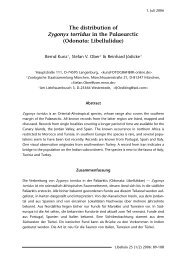(eds.) (2005). - Portal da Biodiversidade dos Açores - Universidade ...
(eds.) (2005). - Portal da Biodiversidade dos Açores - Universidade ...
(eds.) (2005). - Portal da Biodiversidade dos Açores - Universidade ...
You also want an ePaper? Increase the reach of your titles
YUMPU automatically turns print PDFs into web optimized ePapers that Google loves.
particularmente no que se refere à contagem de<br />
espécies. Para tal vamos analisar os quatro grande<br />
grupos de organimos lista<strong>dos</strong> no capítulo 4: Bryophyta<br />
(musgos, antocerotas e hepáticas), Pteridophyta<br />
e Spermatophyta (fetos e fanerogâmicas),<br />
Mollusca (lesmas e caracóis) e Arthropo<strong>da</strong> (centopeias,<br />
diplópodes, crustáceos, aranhas, ácaros, insectos,<br />
etc.). Embora estejamos cientes que muitos<br />
outros grupos taxonómicos deveriam igualmente ter<br />
sido considera<strong>dos</strong> (e.g. líquenes, fungos, nemáto<strong>dos</strong>,<br />
rotíferos, anelídeos, vertebra<strong>dos</strong>), a lista apresenta<strong>da</strong><br />
(ver Cap. 4) engloba a maior fatia <strong>da</strong> biodiversi<strong>da</strong>de<br />
terrestre <strong>dos</strong> <strong>Açores</strong>. Um sumário <strong>da</strong> diversi<strong>da</strong>de de<br />
espécies conheci<strong>da</strong> <strong>dos</strong> <strong>Açores</strong> é apresenta<strong>da</strong> no<br />
Quadro 1. O número total de espécies e ou subespécies<br />
<strong>dos</strong> <strong>Açores</strong> pertencentes aos quatro grupos<br />
principais (briófitos, plantas vasculares, moluscos e<br />
artrópodes) é de cerca de 3705. No entanto, se<br />
adicionarmos outros grupos como os vertebra<strong>dos</strong><br />
(Chor<strong>da</strong>ta, Vertebrata), anelideos (Anneli<strong>da</strong>), nemáto<strong>dos</strong><br />
(Nemato<strong>da</strong>) e líquenes o número de espécies<br />
e subespécies atinge as 4487 (Quadro 1; ver igualmente<br />
a lista de espécies nos Apêndices 2 e 3). Deste<br />
modo cerca de 83% <strong>da</strong> biodiversi<strong>da</strong>de terrestre<br />
conheci<strong>da</strong> <strong>dos</strong> <strong>Açores</strong> é aqui analisa<strong>da</strong> em detalhe.<br />
Se quantificarmos apenas as ver<strong>da</strong>deiras espécies,<br />
então temos 3666 espécies individuais de Bryophyta,<br />
Quadro 1. Número de taxa <strong>da</strong> fauna e flora terrestres <strong>dos</strong> <strong>Açores</strong>.<br />
Table 1. Number of taxa in the terrestrial fauna and flora of the Azores.<br />
Phyla<br />
Espécies<br />
(Species)<br />
26<br />
gamics), Mollusca (slugs and snails) and Arthropo<strong>da</strong><br />
(millipedes, centipedes, mites, spiders,<br />
insects, etc.). Although we are fully aware of the<br />
fact that for a complete listing other groups<br />
should have been considered (e.g. lichens, fungi,<br />
annelids, nematodes, rotifers, vertebrates), the<br />
current list (see Chapter 4) concentrates on the<br />
predominant terrestrial Azorean biodiversity.<br />
A summary of known species diversity in the<br />
Azores is in Table 1. Currently the total number of<br />
terrestrial species and subspecies in the Azores is<br />
estimated of about 3705 (this includes only the<br />
listed individual species or subspecies of bryophytes,<br />
vascular plants, molluscs and arthropods).<br />
However, if we add other groups like vertebrates<br />
(Chor<strong>da</strong>ta, Vertebrata), annelids (Anneli<strong>da</strong>), nematodes<br />
(Nemato<strong>da</strong>) and lichens, this number reaches<br />
4487 species and subspecies (Table 1; see also<br />
lists for the Azores in the Appendices 2 and 3).<br />
Consequently this investigation concentrates on<br />
83% of the known Azorean terrestrial biodiversity.<br />
If we count only the true species, than we have<br />
3666 individual species of Bryophyta, Pteridophyta,<br />
Spermatophyta, Mollusca and Arthropo<strong>da</strong>,<br />
and a total of 4443 species including the<br />
remaining terrestrial groups (Table 1). Therefore,<br />
this implies that we have some species with more<br />
Subespécies<br />
(Subspecies)<br />
Individual<br />
Taxa<br />
Arthropo<strong>da</strong> (1) 2196 115 2209<br />
Spermatophyta (1) 851 101 876<br />
Líquenes (Lichens)* 629 4 632<br />
Bryophyta (1) 437 4 438<br />
Mollusca (1) 111 0 111<br />
Nemato<strong>da</strong>* 80 0 80<br />
Pteridophyta (1) 71 4 71<br />
Chor<strong>da</strong>ta* 47 4 49<br />
Anneli<strong>da</strong>* 21 0 21<br />
TOTAL (1) 3666 224 3705<br />
TOTAL (incl. *) 4443 232 4487<br />
* Ver apêndices 2 e 3 (* see appendices 2 and 3).

















